DIVIDING POLYNOMIALS USING LONG DIVISION
Subscribe to our ▶️ YouTube channel 🔴 for the latest videos, updates, and tips.
The division of polynomials p(x) and g(x) is expressed by the following “division algorithm” of algebra.
Let p(x) and g(x) be two polynomials such that degree of p(x) ≥ degree of g(x) and g(x) ≠ 0. Then there exists unique polynomials q(x) and r (x)
such that
p(x) = g(x) q(x) + r (x) ... (1)
where r (x) = 0 or degree of r (x) < degree of g(x) .
The polynomial p(x) is the dividend, g(x) is the divisor, q(x) is the quotient and r (x) is the remainder.
(1) ==> Dividend = (Divisor x Quotient) + Remainder
Example 1 :
Divide the polynomial 2x3 - 6x2 + 5x + 4 by (x - 2)
Solution :
Let P(x) = 2x3 - 6x2 + 5x + 4 and g(x) = x - 2
To divide the given polynomial by x - 2, we have divide the first term of the polynomial P(x) by the first term of the polynomial g(x).
If we divide 2x3 by x, we get 2x2. Now we have to multiply this 2x2 by x - 2. From this we get 2x3 - 4x2.
Now we have to subtract 2x3 - 4x2 from the given polynomial. So we get -2x2 + 5x + 4.
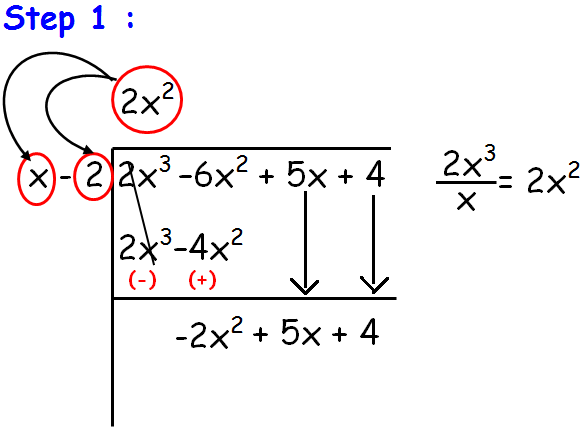
Now we have to subtract 2x3 - 4x2 from the given polynomial. So we get -2x2 + 5x + 4.
repeat this process until we get the degree of p(x) ≥ degree of g(x).
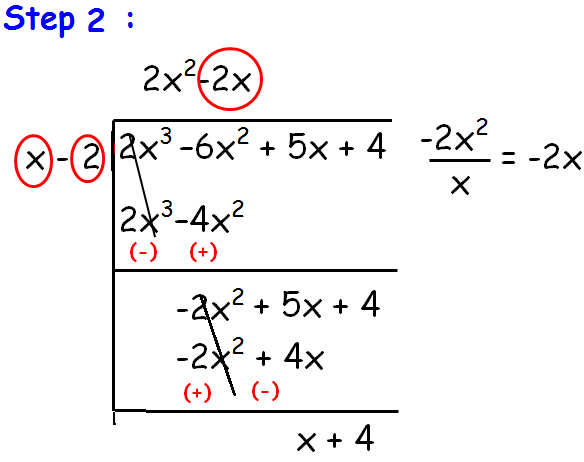
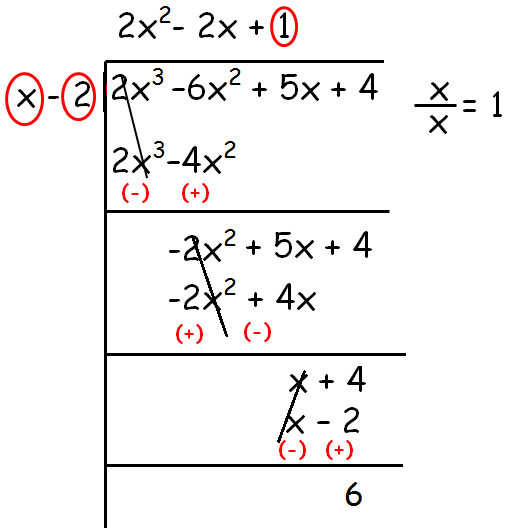
So,
Quotient = 2x2 - 2x + 1
Remainder = 6
Example 2 :
Find the quotient and remainder when 4x3 - 5x2 + 6x - 2 by x - 1.
Solution :
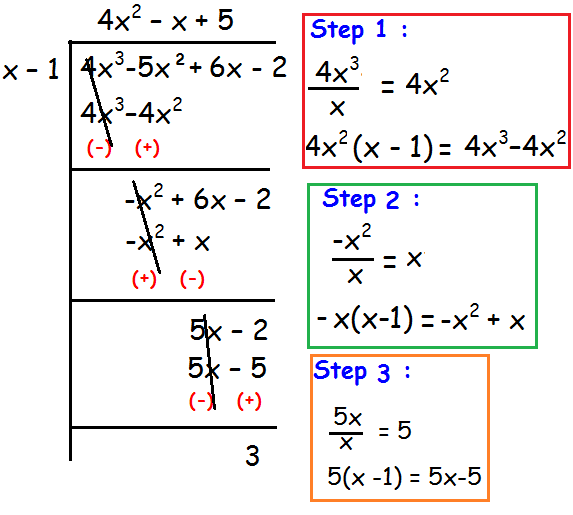
So,
Quotient = 4x2 - x + 5
Remainder = 3
Example 3 :
Find the quotient and remainder when x3 - 7x2 - x + 6 by x + 2.
Solution :
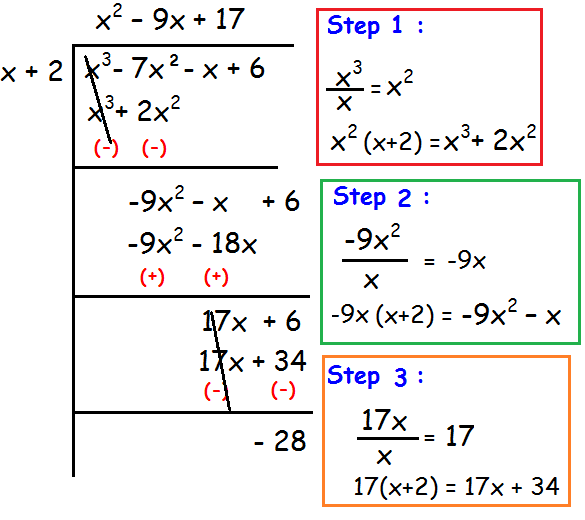
So,
Quotient = x2 - 9x + 17
Remainder = -28
Example 4 :
Find the quotient and the remainder when 10- 4x + 3x2 is divided by x - 2.
Solution :
Let us first write the terms of each polynomial in descending order ( or ascending order).
Thus, the given problem becomes (10- 4x + 3x2) ÷ (x - 2)
f(x) = 10- 4x + 3x2
= 3x2 - 4x + 10
g(x) = x - 2
Step 1 :
In the first step, we are going to divide the first term of the dividend by the first first term of the divisor.
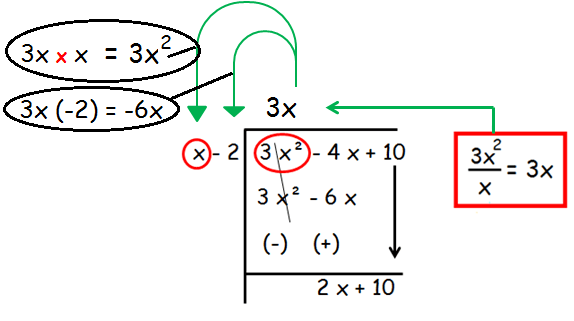
After changing the signs, +3x2 and -3x2 will get canceled. By simplifying, we get 2x + 10.
Step 2 :
In the second step again we are going to divide the first term that is 2x by the first term of divisor that is x.
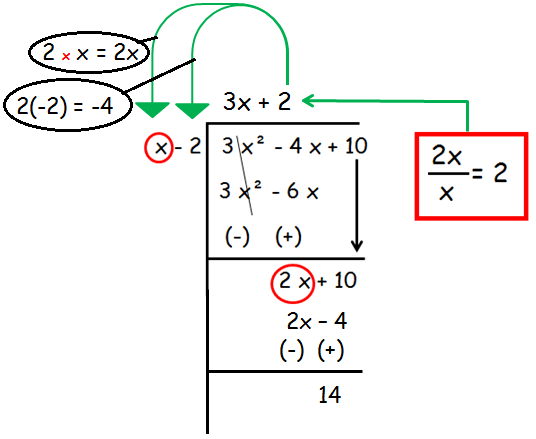
So,
Quotient = 3x + 2
Remainder = 14
Example 5 :
The graph represents the polynomial function
f(x) = x3 + 3x2 − x − 3.
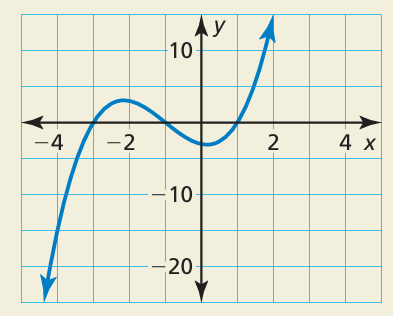
a) The expression f(x) ÷ (x − k) has a remainder of −15. What is the value of k?
b) Use the graph to compare the remainders of
(x3 + 3x2 − x − 3) ÷ (x + 3)
and
(x3 + 3x2 − x − 3) ÷ (x + 1)
Solution :
a)
By observing the graph given above, we trace the point (-4, -15). When x = -4 and y = -15. So, we divide the polynomial f(x) by x + 4 to get the remainder -15.
b)
- When divisor is x + 3, then x + 3 = 0 and x = -3. We trace the point (-3, 0). The remainder is 0 when dividing the polynomial by x + 3.
- When divisor is x + 1, then x + 1 = 0 and x = -1. We trace the point (-1, 0). The remainder is 0 when dividing the polynomial by x + 1.
Example 6 :
If x + 3 is a factor of f(x) = ax2 + bx - 15 in which a and b are constants, what is the value of 3a - b ?
Solution :
f(x) = ax2 + bx - 15
x + 3 is a factor the remainder will become 0.
x + 3 = 0 and x = -3
f(-3) = a(-3)2 + b(-3) - 15
0 = 9a - 3b - 15
9a - 3b = 15
Dividing by 3, we get
3a - b = 15
So, the value of 3a - b is 15.
Example 7 :
The volume V of the rectangular prism is given by
V = 2x3 + 17x2 + 46x + 40
Find an expression for the missing dimension.

Solution :
Length = ?
Width = x + 4 and
height = x + 2
length ⋅ width ⋅ height = volume of rectangular prism
length ⋅ width ⋅ height = 2x3 + 17x2 + 46x + 40
length ⋅ (x + 4) ⋅ (x + 2) = 2x3 + 17x2 + 46x + 40
length ⋅ (x2 + 2x + 4x + 8) = 2x3 + 17x2 + 46x + 40
length = (2x3 + 17x2 + 46x + 40) / (x2 + 2x + 4x + 8)
= (2x3 + 17x2 + 46x + 40) / (x2 + 6x + 8)
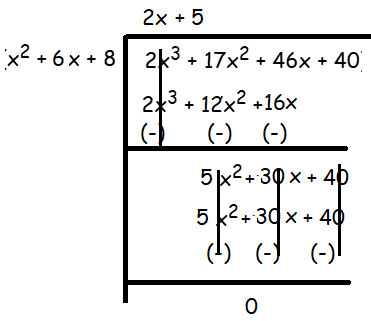
You divide two polynomials and obtain the result
5x2 − 13x + 47 − [102/(x + 2)]
What is the dividend? How did you find it?
Solution :
= 5x2 − 13x + 47 − [102/(x + 2)]
= [(5x2 − 13x + 47)(x + 2) - 102]/(x + 2)
= (5x3 -13x2 + 47x + 10x2 - 26x + 94 - 102) / (x + 2)
= (5x3 -3x2 + 21x - 8) / (x + 2)
So, the dividend is 5x3 -3x2 + 21x - 8.
Subscribe to our ▶️ YouTube channel 🔴 for the latest videos, updates, and tips.
Kindly mail your feedback to v4formath@gmail.com
We always appreciate your feedback.
About Us | Contact Us | Privacy Policy
©All rights reserved. onlinemath4all.com
Recent Articles
-
Quantitative Reasoning Questions and Answers
Dec 14, 25 06:42 AM
Quantitative Reasoning Questions and Answers -
Specifying Units of Measure
Dec 14, 25 06:38 AM
Specifying Units of Measure -
Coin Tossing Probability
Dec 13, 25 10:11 AM
Coin Tossing Probability - Concept - Sample Space - Formula - Solved Problems